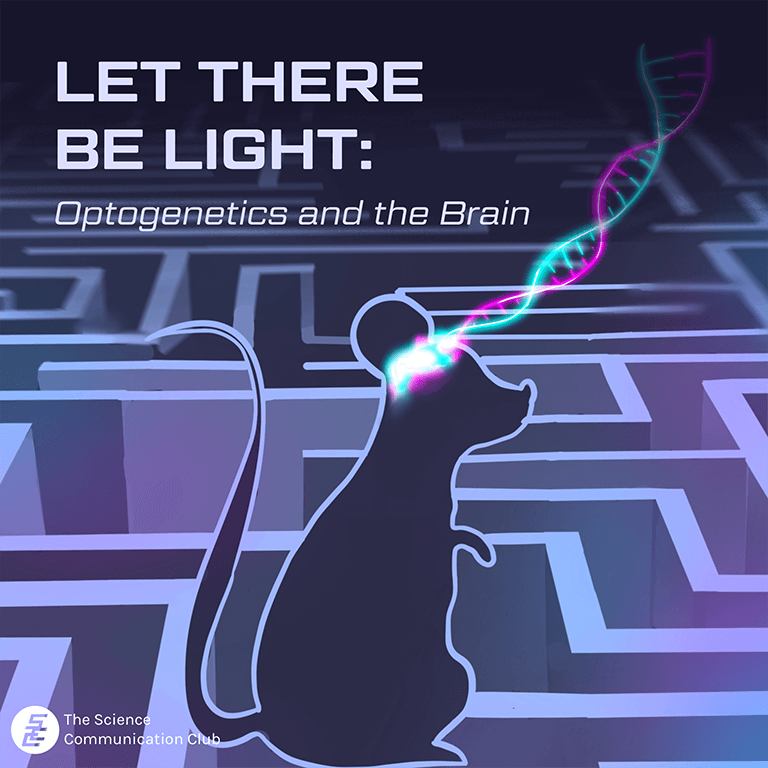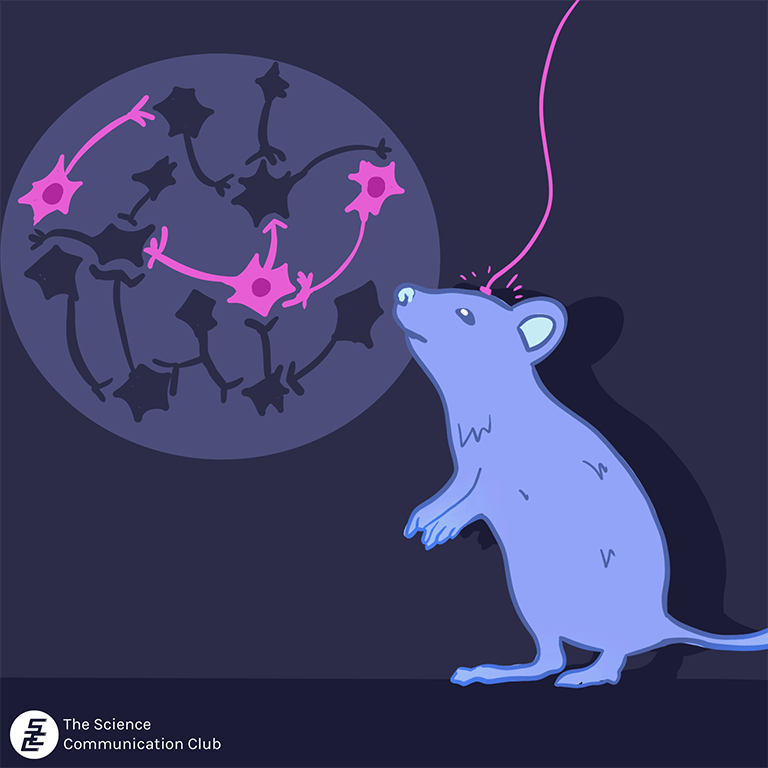
Written and illustrated by Charlotte Zhang
Imagine this: someone puts a light bulb in your brain. As the bulb switches on and off, it controls the activity of your brain cells. By targeting different cells, it might make you feel intense emotions, wake you up or put you to sleep, or even make you temporarily smarter. As much as this concept sounds like something out of a far-fetched science fiction story, it’s actually becoming a reality thanks to advancements in the field of optogenetics.
Optogenetics, like its name, combines light with genetic techniques to achieve a variety of manipulations on brain cells. The activation of cells relies on the electric current generated through the influx of positively charged ions. These ions flow in and out of the cell through channels embedded in the cell membrane. Optogenetics makes use of this property by installing channels that can only be open or closed by different colors of light beams. These channels are called opsins Some common opsins include channelrhodopsins, which are sensitive to blue light only, and halorhodopsins, which are sensitive to orange light1. These channels can be expressed on a wide variety of cells in a given region, or they can be genetically engineered to only be expressed on specific types of cells. This is important because in the brain, cells that are responsible for specific brain functions usually have very distinct cell types. Through their specificity to certain frequencies of light, and through selectively targeting these cells we can achieve very precise control of their activity, and it could translate to very fine-tuned outcomes in the brain2.

Currently, optogenetics is widely used in a variety of psychiatric studies. For example, it is widely used on mouse models to study depression3. In depression studies, the opsins are usually injected directly into the desired area in the brain where it is selectively expressed in a specified type of brain cells. A light electrode is then inserted into the area of interest, and the mouse’s behaviour when the light is on and off is compared in different tests evaluating depression symptoms. By combining optogenetic manipulations with behavioural tests, scientists are able to investigate which specific groups of neurons are associated with different depression-related symptoms. Moreover, by using different types of opsins at once, they can further infer the connectivity between different subtypes of neurons to elucidate a whole “network” that underlies depression. Similarly, this technique is also widely used in sleep studies to figure out the circuit underlying sleep and wakefulness. It can also be used in investigations on addiction by stimulating dopamine-producing cells4. It is vitally important to investigate these underlying mechanisms behind psychiatric conditions because our current understanding still remains ambiguous and bettering this understanding could lead to development of more effective therapeutics and eliminate off-target side effects.
Optogenetics has been a useful tool for deciphering the brain. This technique turns the previously complex brain a collective of different types of neurons working together, with each subtype of neurons affecting the overall output. This field is still advancing at a rapid pace after two decades of research. Perhaps the day where we can freely switch certain functions of our brain on and off might not be too far away after all.
Sources:
- Shirai F, Hayashi-Takagi A. Optogenetics: Applications in psychiatric research: Optogenetics for psychiatric research. Psychiatry and clinical neurosciences. 2017;71(6):363–372. http://dx.doi.org/10.1111/pcn.12516. doi:10.1111/pcn.12516
- Berglund K, Stern MA, Gross RE. Bioluminescence-optogenetics. Advances in experimental medicine and biology. 2021;1293:281–293. http://dx.doi.org/10.1007/978-981-15-8763-4_17. doi:10.1007/978-981-15-8763-4_17
- Fakhoury M. Optogenetics: A revolutionary approach for the study of depression. Progress in neuro-psychopharmacology & biological psychiatry. 2021;106(110094):110094. https://www.sciencedirect.com/science/article/pii/S0278584620304103. doi:10.1016/j.pnpbp.2020.110094
- Entcheva E, Kay MW. Cardiac optogenetics: a decade of enlightenment. Nature reviews. Cardiology. 2021 [accessed 2022 Oct 19];18(5):349–367. https://pubmed.ncbi.nlm.nih.gov/33340010/. doi:10.1038/s41569-020-00478-0